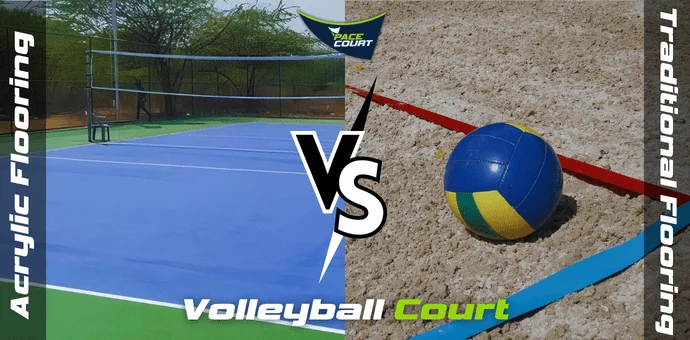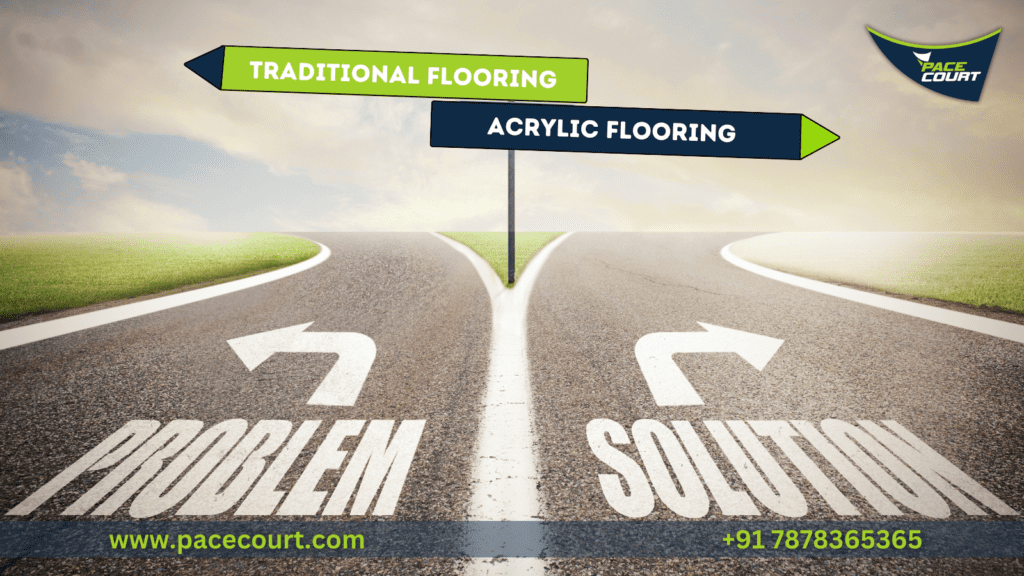
Volleyball, a sport loved by millions, has seen significant evolution not just in how it's played but also where it's played. From sandy beaches to wooden gymnasium floors, the diversity of playing surfaces is vast. One of the latest advancements in this arena is the use of acrylic flooring for outdoor volleyball courts. Brought into focus by industry leaders like Pacecourt, acrylic surfaces offer a modern alternative with a multitude of benefits. In this article, we’ll delve deep into the advantages of Acrylic Flooring vs Traditional Volleyball Court materials.
1. Durability and Longevity
Traditional Surfaces: Over time, materials like asphalt or concrete can develop cracks due to natural wear and tear. Similarly, wooden courts are susceptible to warping or damage from moisture.
Acrylic Flooring: Known for its resilience, acrylic can withstand intense play, environmental factors, and the test of time. With proper maintenance, these courts can last for many years without significant wear.
2. Player Safety and Comfort
Traditional Surfaces: Hard surfaces can be unforgiving on player joints, leading to a higher risk of injuries. Grass courts, while softer, can be uneven, posing tripping hazards.
Acrylic Flooring: Designed with players in mind, acrylic sport court offer optimal shock absorption. This not only reduces the impact on knees and ankles but also provides a smoother and more consistent playing surface.
3. Versatility and Customization
Traditional Surfaces: Customization options for asphalt, grass, or wooden courts are limited, often requiring additional resources and time.
Acrylic Flooring: One of the standout features is its adaptability. Whether it's incorporating team colors, logos, or specific design elements, acrylic offers unparalleled customization capabilities.
4. Consistent Playing Experience
Traditional Surfaces: Environmental factors can greatly affect the performance of natural or older synthetic surfaces. Rain can make wooden courts slippery and grass courts muddy, while heat can soften asphalt.
Acrylic Flooring: Acrylic courts provide a uniform bounce and grip, ensuring that players can maintain consistent gameplay regardless of weather conditions.
5. Low Maintenance and Easy Cleaning
Traditional Surfaces: Wooden courts require periodic polishing and can be damaged by water. Asphalt courts might need resurfacing due to cracks.
Acrylic Flooring: Being resistant to water and UV rays, acrylic courts are easy to clean and maintain. Simple cleaning routines can keep them looking new and vibrant.
6. Environmentally Friendly
Traditional Surfaces: The production and disposal of some traditional materials can have environmental implications.
Acrylic Flooring: Modern acrylic flooring solutions, like those from Pacecourt, prioritize sustainability. These surfaces are often recyclable, leading to a smaller environmental footprint.
7. Cost-Effectiveness
Traditional Surfaces: The frequent maintenance and potential for early replacement can lead to higher long-term costs.
Acrylic Flooring: While the initial investment can be higher, the durability and low maintenance requirements of acrylic make it a cost-effective solution in the long run.
8. Weather Resistance
Traditional Surfaces: Prolonged exposure to the elements can deteriorate the quality of many traditional court materials.
Acrylic Flooring: Acrylic is designed to resist various weather conditions, from the scorching sun to heavy rainfall, ensuring longevity and consistent playability.
9. Aesthetically Pleasing
Traditional Surfaces: Wear and tear are more visible, and design possibilities are limited.
Acrylic Flooring: With a glossy finish and the ability to incorporate vibrant designs, acrylic courts are not just functional but also visually appealing.
10. Adaptability for Multiple Sports
Traditional Surfaces: Courts designed for one sport might not suit another.
Acrylic Flooring: With slight modifications, an acrylic volleyball court can easily be adapted for other sports, making it a versatile choice for multi-sport facilities.

Slide, Bounce, Win! All on Our Acrylic Sports Surface.
| Tennis Court Flooring | Basketball Court Flooring | Volleyball Court Flooring |
| Badminton Court Flooring | Skating Rink | Walking track |
Conclusion
Acrylic Flooring vs Traditional Volleyball Court debates have taken center stage recently. Championed by pioneers like Pacecourt, acrylic flooring is setting new standards in the world of outdoor sports surfaces. Its superior durability, player-centric design, and adaptability make it an excellent choice for modern volleyball courts. While traditional surfaces hold their own place and charm, the multifaceted advantages of acrylic flooring are reshaping the way we think about outdoor sports infrastructure.


